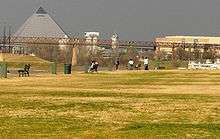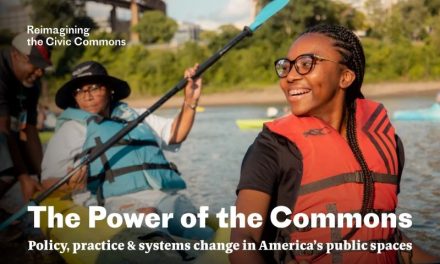Tom Lee Park is a room with a view.
It’s a magnificent view but the room is empty.
That’s because Tom Lee Park is essentially a field without any activity beyond the month of May or anything to make it more than a spectacular backdrop for joggers or more than a photo op for visitors.
Expanding the Vision, Not Just the Size
When the park was expanded from a four and half acre sliver in 1991 to 25 acres, it was about engineering, not placemaking. Carol Coletta, president of ArtPlace, a national creative placemaking program, said: “Tom Lee Park was an incredible civic gift from the engineers, but from the perspective of the visitor experience, it’s a wholly inadequate park. The question is ‘how do we take that asset and make a park that lives up to its location?’”
It’s a question that’s come up in meetings about “how to build a world-class riverfront” being conducted for the Riverfront Development Corporation by Caissa Public Strategies. Paige Walkup of Caissa said: “People say they enjoy the space, but there’s so much to be done to heighten the experience. Someone said that after she’s taken her child to see the view once, she has more to do in her neighborhood park.”
About a decade ago, city traffic engineers kicked off a controversy when they proposed to widen and straighten Riverside Drive, once again underscoring the words of former National Endowment for the Arts Director of Design Jeff Speck who said three years ago that “Memphis should not leave the design of the city to traffic engineers.”
Creating a World-Class Park for a World-Class View
As part of the process to consider Riverside Drive’s options, Frank Ricks of Looney Ricks Kiss Architects prepared some rough drawings for three “rooms” at Tom Lee Park that responded to the needs of Memphis in May. “The park’s so long and linear and the three rooms could be created by trees or by an allee of trees lined up with the bluff stairway,” he said. “It’s a world-class view, but it’s barren. It needs something to give it context and human scale.”
Ricks’s ideas also included performing space on the hill on the south end of the park, ways to get closer to the river, and a better urban edge that removes the overgrowth of shrubs and plants at river’s edge. Coletta said the park could benefit from a variety of landscapes, paving materials, and uses.
Landscape architect Ritchie Smith, referring to the ways the land can be contoured to make it more interesting, said: “If you assume Memphis in May remains there, I wonder if there are gentle land forms that could be created to make the park more interesting.”
Adding More to Do
If the decision was made to move Memphis in May, he said a master plan should be developed. Ideas could involve more trees and plantings, improved restrooms and pavilion, places for children to play, picnicking, sand beach volleyball, zones around the Tom Lee sculpture and obelisk, all park benches on pads adjacent to the sidewalks, and sculptural and dramatic land forms “to break the park into distinct areas to create definition so it’s not an undifferentiated treeless lawn with a monotonous topography.”
Now, Tom Lee Park embodies two drawbacks frequently found in public spaces here. First, there are weak connections to other nearby civic places. In the case of Tom Lee Park, that means it needs strong connections to Beale Street Landing (connections weakened with the present parking lot for Beale Street Landing) and Mud Island. “You have to connect Tom Lee Park psychologically and physically to Beale Street Landing,” said Ricks.
Second, there is an absence of the kind of programming and activities that distinguish great public spaces. At Tom Lee Park, there is no programming beyond the three weekend events of Memphis in May.
Achieving the Potential
Said Coletta: “The park is programmed during Memphis in May, so today, we have a crescendo of activity and then we leave it as barren festival grounds for the rest of the year. I’m all for Memphis in May remaining downtown, but if it were mine to do, I’d move it out of Tom Lee Park. The park is one of our greatest untapped civic assets and it can be a great place.”
Today, Memphis squanders its potential to develop a park that lives up to one of the most spectacular river views in the U.S. Twenty years ago, Memphis backed into the decision for Tom Lee Park to be our festival grounds, but facing the opening of Beale Street Landing, it seems the perfect time to consider how Memphis can turn Tom Lee into a park.
This post was previously published in the December issue of Memphis magazine.





That’s all we need is something else for the RDC to screw up.
While I am very supportive of the completion of Beale Street Landing, I cannot help but think that perhaps a renovation of Tom Lee should have been a higher priority on the RDC’s list of projects.
Build a pedestrian bridge at grade with Riverside Drive that would connect Mud Island to Tom Lee thus allowing for the festival to program some of its more intense activities further north. This would also give Mud Island more of a reason for being. Make it a swing or raising bridge to permit port/ Coast Guard access. Then go all in on a re-design of Tom Lee. Perhaps the necessary adjustments are minor (grading and landscaping) or maybe they need to be more significant (water features, overlooks, plazas, etc…). If we are going to insist that it serve as a sort of “fairgrounds on the river”, then as SCM suggests, using it beyond the month of May is a must. Additional music and food festivals, crafts markets, auto & marine shows, aviation festivals and outdoor movie programming should all be considered.
Inactivity is in the eyes of the beholder. While I would support upgrading the park, it is full–and often packed– on a nice weekend evening to watch the sunset. So is the Bluffwalk, from what I see when I lead sunset walks for Sierra Club. Sunsets are the best show in town!
MIM is Tom Lee Park – relocate it??
Anon 11:11- Define “full” and “packed”.
Steve: We didn’t mention RDC or who should be in charge of making Tom Lee into a Park, but as for the RDC, it’s pretty hard to see how anybody can screw up a place as bleak as this one.
Anonymous: Sunsets are the best show in town and reason enough to live and work down here, but what about the other 23 hours a day. As for Memphis in May, we would relocate it in a heartbeat since those approximately 10 days tears up the park for weeks and they are an obstacle to a more smartly-defined, more enjoyable park. That said, as Frank Ricks and Ritchie Smith have said, there’s a way to make the park more enjoyable without meaning that MIMIF has to move.
At risk of sounding like a broken record… ball fields. There are already pick-up soccer games held there. Between Greenbelt Park, Civic Center Plaza, Court Square, Confederate & Jefferson Davis Park, to the cobblestones and Tom Lee, there is an extraordinary amount of public space amenities. Few are programmed worth a flip or maintained very well. But all serve a nice purpose and have some traffic. Athletic & exercise facilities are missing.
This could coexist with better landscaping, existing users, MIM and new programming.
One of my favorite experiences is watching pick-up softball games on the National Mall in DC… which is also just a big swath of grass with an awesome backdrop.
Urbanut: We have no argument about the priorities that you suggest Memphis should have had.
John: Great ideas. It is possible…if we can think differently about possibilities.
I run a BBQ Team…We have been down on that river since before the downtown revitalization… For the 2011 Festival events, Memphis in May generated an economic impact of $76,506,384 supporting 939 jobs…what will your park without MIM generate? What money will the hotels and restaurants in the area lose without MIM downtown? Maybe you need to find a way to beautify and coexist…
It’s paramount to the success of any Tom Lee Park re-imagining, that the GRAND view it provides not be compromised. I agree with the commenter above who pointed out that Tom Lee does get used, simply to admire the sunset and the view. I am of the opinion that IF more people lived within walking distance, Tom Lee would be much more vibrant, the way you see people walking and biking all afternoon on the (crappy) paths on Mud Island. Tom Lee would enjoy the same kind of use, were a couple thousand more people living within a ten minute walk. The last thing you want to do is orient the park towards automobile traffic and clear out space to provide parking on the riverfront. That would be classic blunder, but it’s almost assured that if redevelopment efforts come up now, the RDC will want to accommodate automobiles. As long as the current iteration of RDC is in charge, how can you possibly trust what they would do to a civic treasure? I definitely do not.
Urbanut, you are an astute observer and commentator, but I would love to hear why you are such a supporter of Beale Street Landing; a project that, in my mind, reflects everything that is wrong with the Riverfront Development Corporation and City of Memphis-led downtown and economic development efforts. I don’t see how it will possibly ever justify it’s expense. It’s design visually cuts off what is supposed to be the critical use of the project, the return of the riverboats, from the rest of the city. You’ll have to be on the other side of the artificial “mound” to truly see or maybe even know about the riverboats mooring there. The “mound” looks like a highway construction project gone bad that someone decided to turf over. Personally, it’s an over-expensive eyesore that serves minimal usefulness. Feel free to reply.
I can’t even express how much I hate Beale Street Landing. How can you screw up a dock that badly?
Anon 9:14,
I think I need to define “supporter” for both our sakes. I “support” completion of the project as opposed to the half completed work that sat idly for so long. The only thing worse than a misguided project is a half completed misguided project which acts as a physical barrier on the riverfront.
From what I have seen of the plans (http://www.memphisriverfront.com/projects/beale-street-landing), the actual docking facility will extend north of the mound toward Beale Street, making it conceivable that one will be able to see the moored ships when looking down Beale Street itself and when standing at the intersection of Beale and Riverside. I cannot speak for the designer, but I would imagine that the mound was offset to the south of the Beale-Riverside intersection in order to preserve the view of the harbor/river from Beale. As currently designed, the only point at which one’s view of docking ships and the river will be interrupted by the mound will be a roughly 400’ stretch of Riverside to the south of the Beale intersection. Opposite this stretch is the bluff where no construction can occur. At the top of the bluff, the view from the city will still be uninterrupted as it is well above the height of the mound.
As for the mound itself, I am withholding judgment until completion. The concept is intriguing: a grassy sloped extension of Tom Lee up to a point where an elevated view of the Harbor and River can be had without climbing the stairs to the top of the bluff.
By the way, I agree re: auto orientation. It is a travesty that so much of the park has already been devoted towards parking. I would have much preferred either dedicating the outside lane or even widening Riverside to accommodate an area for on-street parking as opposed to the massive lots that are in place. Maybe dedicating the outside lanes on both sides of Riverside to on-street parking on the weekends? Fortunately this would be a fairly simple task to accomplish.
John- just wanted to say I agree with your comments regarding ball fields and programming. I’ll refer back to my original post that mentions the pedestrian bridge. It is my opinion- and nothing more- that it is critical that we create a link between Greenbelt Park, Mud Island Riverpark, the Cobblestones, Tom Lee, Martyrs Park and the Harahan in as seamless a manner as possible in order to create the backbone of a great riverfront. Once accomplished, we could actually address the entirety of the riverfront- a great public space some 4 miles in length- as one single great linear park instead of the patchwork quilt approach that has been taken to date.
Neil- I agree per MIM. I also think there is a way to coexist. One individual that posts here occasionally was quick to point out Portland’s heavily used riverfront park. Festivals, concerts and general use can coexist with a scenic and green park. By expanding our concept of the riverfront beyond Tom Lee it would be possible to expand MIM’s borders to say Mud Island River Park. I harp on the pedestrian connection to Mud Island simply b/c I think it is so critical to the success of our riverfront. Maybe such a crossing could be made wide enough to allow for tents and teams to set up along the bridge itself in a Bar-B-Que rendition of the bridges of Florence. It would certainly allow for a little more breathing room for an even where walkways between team tents becomes impossibly congested during peak periods.
Bar-B-Que rendition of the bridges of Florence – sounds awesome in theory. But can you put 7 or 8 three story scaffold structures stocked with 300 people each on a bridge? If so, sign us up
On a side note – we teams don’t like space between our tents…it allows people to sneak in 😉
Neil- I guess in theory one could. I would imagine that the catch for what would be the most unique location in the festival might be a height limit. As for spreading out, not thinking so much between tents (side to side or back to back) but allowing for wider walkways between (front to front). I actually enjoyed the Fairgrounds layout this past year simply b/c there was space to walk even during the peak periods without the use of a crowbar.
The best scenario would be Tom Lee Park’s beauty being enhanced without losing any square footage for festivals. Adding wide tree-lined pedestrian promenades or in the example above, a wide pedestrian bridge capable of heavy loads, would accomplish this without the loss of the parks ability to shoulder festivals. Tom Lee should definitely not have any parking added to it, if anything it should be taken away.
I think moving a long-standing tradition such as MIM simply is not an option. It is a showcase of downtown, and with our cities greatest asset lapping at your feet, it draws people from all over the world. BBQ Fest was moved last year due to the flooding, but many companies and teams threatened to not return if it didn’t move back to the river. Changing the park’s landscape too drastically will force a move, and the loss of a tradition that has been in the park since 1979. I understand the need for progress, but please don’t let progress blind the need for tradition.
Neil: Why is it not possible to move MIMIF if that’s best for the broader use by the public of a higher quality site? It’s the public’s space, not Memphis in May, and the barbecue participants seemed pretty happy at Tiger Lane, according to MIMIF officials. We can at least discuss other options for MIMIF’s location, and we are confident Memphis in May would put what’s best for the city ahead of its own narrow interest. After all, it was that kind of civic spirit that led to the founding of the festival in the first place. If we were locked into tradition, the music festival would still be on Beale Street and some activities would still be centered on Court Square. Times change, needs change, and fortunately, downtown has come alive enough that we should think of the highest and best use of Tom Lee Park for the most people for the most amount of time. If MIMIF can work in a better park, more the better, but it should not preclude us from dreaming big to have the kind of special places that other cities have on their riverfronts.